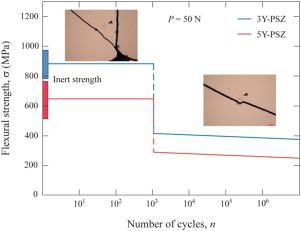Dental Materials ( IF 4.6 ) Pub Date : 2020-11-21 , DOI: 10.1016/j.dental.2020.10.019 Marcia Borba 1 , Tomoyuki K Okamoto 2 , Michelle Zou 3 , Marina R Kaizer 4 , Yu Zhang 2

|
Objective
Mechanical damages can occur from dental restoration processing and fitting, or while it is in-service. This study evaluates the damage sensitivity of translucent zirconia (5Y-PSZ) relative to conventional 3Y-PSZ following mouth-motion simulations at various loads.
Methods
5Y-PSZ and 3Y-PSZ discs were adhesively bonded to a dentin-like substrate and divided into groups according to the load (50 N or 200 N) and number of cycles (up to 106) used in the chewing simulation. Specimens were mounted with 30° inclination in an electrodynamic mouth-motion simulator, and subjected to contact-slide-liftoff cyclic loading in water. Surface and sub-surface damages were analyzed using a sectioning technique. After the simulation, specimens were removed from the substrate and loaded with the damaged surface in tension for biaxial strength testing to assess their damage tolerance.
Results
The strength of both ceramics underwent significant degradation after mouth-motion simulations. For 5Y-PSZ, the strength degradation was greater (∼60%) and occurred at a lower number of cycles than 3Y-PSZ. Herringbone cracks emerged on 3Y-PSZ and 5Y-PSZ surfaces under a 200-N load after 50 and 10 cycles, respectively. Meanwhile at a 50-N load, cracks formed at ∼1000 cycles in both ceramics. Further increasing the number of cycles only had moderate effects on the strength of both ceramics, despite an increase in surface and sub-surface damage. More significantly, a 50-N occlusal load can debase the zirconia strengths as much as a 200-N load.
Significance
Surface flaws produced during the chewing simulation are capable of significant strength degradation in zirconia, even after a small number of low-load cycles.
中文翻译:

牙科氧化锆对模拟咬合接触的损伤敏感性
客观的
机械损坏可能发生在牙齿修复处理和安装过程中,或者在使用过程中。本研究评估了半透明氧化锆 (5Y-PSZ) 相对于传统 3Y-PSZ 在不同负载下的嘴部运动模拟后的损伤敏感性。
方法
将 5Y-PSZ 和 3Y-PSZ 椎间盘粘合到类牙本质基质上,并根据咀嚼模拟中使用的负载(50 N 或 200 N)和循环次数(最多 10 6)分为几组。将样本以 30° 倾斜角安装在电动口腔运动模拟器中,并在水中承受接触-滑动-升力循环载荷。使用切片技术分析表面和亚表面损伤。模拟结束后,将试样从基材上取下,并在张力下加载受损表面进行双轴强度测试,以评估其损伤容限。
结果
在嘴部运动模拟后,两种陶瓷的强度都显着下降。与 3Y-PSZ 相比,5Y-PSZ 的强度下降更大(~60%)并且发生的循环次数更少。在 200-N 载荷下,3Y-PSZ 和 5Y-PSZ 表面分别在 50 和 10 次循环后出现人字形裂纹。同时,在 50-N 载荷下,两种陶瓷在约 1000 次循环时都会形成裂纹。尽管表面和亚表面损伤增加,但进一步增加循环次数仅对两种陶瓷的强度产生中等影响。更重要的是,50-N 的咬合载荷会降低氧化锆的强度,就像 200-N 的载荷一样。
意义
咀嚼模拟过程中产生的表面缺陷能够显着降低氧化锆的强度,即使在少量低负荷循环之后也是如此。











































 京公网安备 11010802027423号
京公网安备 11010802027423号